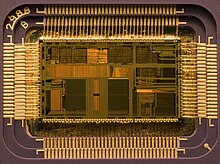Intel DX2
This article has multiple issues. Please help improve it or discuss these issues on the talk page. (Learn how and when to remove these messages)
|

The Intel486 DX2[1], rumored as 80486DX2 (later renamed IntelDX2), is a CPU produced by Intel that was first introduced in 1992. The i486DX2 was nearly identical to the i486DX, but it had additional clock multiplier circuitry. It was the first chip to use clock doubling, whereby the processor runs two internal logic clock cycles per external bus cycle. An i486 DX2 was thus significantly faster than an i486 DX at the same bus speed thanks to the 8K on-chip cache shadowing the slower clocked external bus. Both 25/50 and 33/66 MHz Intel486 DX2 CPU uses the 800 nm process technology.[2] With the internal clock doubler CPU, it boosts between 50 to 70 percent overall system performance than the original Intel486 DX series.[3] In other words, the 50-MHz Intel486 DX2 provides about 70 percent improvement over the 25-MHz Intel486 and about 30-percent improvement over the 33-MHz Intel486 CPU. The 50-MHz Intel486 DX2 CPU were rated at 40 Dhrystone MIPS.[4]
The i486DX2-66 was a very popular processor for video games enthusiasts in the early to mid-90s. Often coupled with 4 to 8 MB of RAM and a VLB video card, this CPU was capable of playing virtually every game title available for years after its release, right up to the end of the MS-DOS game era, making it a "sweet spot" in terms of CPU performance and longevity. The introduction of 3D graphics spelled the end of the 486's reign, because of their heavy use of floating point calculations and the need for faster cache and more memory bandwidth. Developers began to target the P5 Pentium processor family almost exclusively with x86 assembly language optimizations which led to the usage of terms such as Pentium compatible processor for software requirements. An i486DX2-50 version was also available, but because the bus speed was 25 MHz rather than 33 MHz, this was a significantly less popular processor.
There are two major versions of the DX2 - Identified by P24 and P24D, the latter has a faster L1 cache mode, called "write-back", that improves performance. The original P24 version offered only the slower "write-through" cache mode. AMD and Cyrix both produced a competitor for the Intel i486DX2.
The 50-MHz Intel486 DX2 were available in production volumes for USD $550 each in 1,000-pieces quantities at the time of the press.[5]
-
An Intel i486DX2-66 Microprocessor, top view.
-
The bottom view with gold plated pins visible.
-
Embedded i486DX2 (SL enhanced, SQFP version).
References
[edit]- ^ Hodson, Gerri, "The Intel486 DX2 Microprocessor: Speed-Doubler Technology", Intel Corporation, Microcomputer Solutions, May/June 1992, page 2-5
- ^ Intel Corporation, "Coming Attractions: Clock-Doubling Technology", Microcomputer Solutions, January/February 1992, page 6
- ^ Intel Corporation, "A Guide to the Intel Architecture", Microcomputer Solutions, January/February 1992, page 11
- ^ Hodson, Gerri, "The Intel486 DX2 Microprocessor: Speed-Doubler Technology", Intel Corporation, Microcomputer Solutions, May/June 1992, page 2-5
- ^ Hodson, Gerri, "The Intel486 DX2 Microprocessor: Speed-Doubler Technology", Intel Corporation, Microcomputer Solutions, May/June 1992, page 2-5
See also
[edit]External links
[edit]Intel Datasheets



